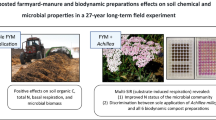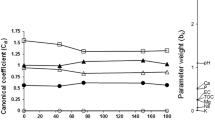Abstract
A greenhouse experiment was conducted to investigate the impact of sewage sludge compost application on functional diversity of soil microbial communities, based on carbon source utilization, and biochemical characteristics of tree peony (Paeonia suffruticosa). Functional diversity was estimated with incubations in Biolog EcoPlates and well color development was used as the functional trait for carbon source utilization. The average well color development and Shannon index based on the carbon source utilization pattern in Biolog EcoPlates significantly increased with the increasing sludge compost application in the range of 0–45 %, with a decreasing trend above 45 %. Principal component analysis of carbon source utilization pattern showed that sludge compost application stimulated the utilization rate of d-cellobiose and α-d-lactose, while the utilization rate of β-methyl-d-glucoside, l-asparagine, l-serine, α-cyclodextrin, γ-hydroxybutyric acid, and itaconic acid gradually increased up to a sludge compost amendment dosage of 45 % and then decreased above 45 %. The chlorophyll content, antioxidase (superoxide dismutase, catalase, and peroxidase) activities, plant height, flower diameter, and flower numbers per plant of tree peony increased significantly with sludge compost dosage, reaching a peak value at 45 %, and then decreased with the exception that activity of superoxide dismutase and catalase did not vary significantly.



Similar content being viewed by others
References
Allen SE, Grimshaw HM, Rowland AP (1986) Chemical analysis. In: Moore PD, Chapman SB (eds) Methods in plant ecology. Blackwell Scientific Publication, London, pp 285–344
Arnon DI (1949) Copper enzymes in isolated chloroplasts: polyphenoloxidase in Beta vulgaris. Plant Physiol 24:1–15
Bhattacharya T, Chakraborty S, Banerjee DK (2010) Heavy metal uptake and its effect on macronutrients, chlorophyll, protein, and peroxidase activity of Paspalum distichum grown on sludge-dosed soils. Environ Monit Assess 169:15–26
Brookes PC (1995) The use of microbial parameters in monitoring soil pollution by heavy metals. Biol Fertil Soils 19:269–279
Chaerun SK, Pangesti NPD, Toyota K, Whitman WB (2011) Changes in microbial functional diversity and activity in paddy soils irrigated with industrial wastewaters in Bandung, West Java Province, Indonesia. Water Air Soil Pollut 217:491–502
Chang EH, Chung RS, Tsai YH (2007) Effect of different application rates of organic fertilizer on soil enzyme activity and microbial population. Soil Sci Plant Nutr 53:132–140
Curaqueo G, Schoebitz M, Borie F, Caravaca F, Roldán A (2014) Inoculation with arbuscular mycorrhizal fungi and addition of composted olive-mill waste enhance plant establishment and soil properties in the regeneration of a heavy metal-polluted environment. Environ Sci Pollut Res 21:7403–7412
De Paula AM, da Fonseca AF, Cardoso EJBN, Melfi AJ (2010) Microbial metabolic potential affected by surplus wastewater irrigation in tropical soil cultivated with tifton 85 bermuda grass (Cynodon dactylon Pers. × C. niemfuensis Vanderyst). Water Air Soil Pollut 205:161–171
Delgado-Baquerizo M, Morillas L, Maestre FT, Gallardo A (2013) Biocrusts control the nitrogen dynamics and microbial functional diversity of semi-arid soils in response to nutrient additions. Plant Soil 372:643–654
Garland JL (1996) Analytical approaches to the characterisation of samples of microbial communities using patterns of potential C source utilisation tests. Soil Biol Biochem 28:213–221
Garland JL (1997) Analysis and interpretation of community level physiological profiles in microbial ecology. FEMS Microbiol Ecol 24:289–300
Girvan MS, Bullimore J, Pretty JN, Osborn AM, Ball AS (2003) Soil type is the primary determinant of the composition of the total and active bacterial communities in arable soils. Appl Environ Microbiol 69:1800–1809
Havir EA, Mchale NA (1987) Biochemical and developmental characterization of multiple forms of catalase in tobacco leaves. Plant Physiol 84:450–455
Hua L, Wang YL, Wu WX, McBride MB, Chen YX (2008) Biomass and Cu and Zn uptake of two turfgrass species grown in sludge compost–soil mixtures. Water Air Soil Pollut 188:225–234
Huang X, Xue D, Xue L (2014) Changes in microbial biomass, activity, functional diversity, and enzyme activity in tree peony (Paeonia suffruticosa) garden soils. Hortsicence 49:1408–1413
Jiang XJ, Liu W, Liu Q, Jia ZJ, Wright AL, Cao ZH (2013) Soil N mineralization, nitrification and dynamic changes in abundance of ammonia-oxidizing bacteria and archaea along a 2000 year chronosequence of rice cultivation. Plant Soil 365:59–68
Kachout SS, Mansoura AB, Leclerc JC, Mechergui R, Rejeb MN, Ouerghi Z (2009) Effects of heavy metals on antioxidant activities of Atriplex hortensis and A. rosea. J Food Agric Environ 7:938–945
Lei YB, Korpelainen H, Li CY (2007) Physiological and biochemical responses to high Mn concentrations in two contrasting Populus cathayana populations. Chemosphere 68:686–694
Leininger S, Urich T, Schloter M, Schwark L, Qi J, Nicol GW, Prosser JI, Schuster SC, Schleper C (2006) Archaea predominate among ammonia-oxidizing prokaryotes in soils. Nature 442:806–809
Liu F, Wu J, Ying GG, Luo Z, Feng H (2012) Changes in functional diversity of soil microbial community with addition of antibiotics sulfamethoxazole and chlortetracycline. Appl Microbiol Biot 95:1615–1623
Manios T, Stentifor EI, Millner PA (2003) The effect of heavy metals accumulation on the chlorophyll concentration of Typha latifolia plants, growing in a substrate containing sewage sludge compost and watered with metaliferus water. Ecol Eng 20:65–74
McGuire KL, Treseder KK (2010) Microbial communities and their relevance for ecosystem models: decomposition as a case study. Soil Biol Biochem 42:529–535
Mittler R, Zilinskas BA (1991) Purification and characterization of pea cytosolic ascorbate peroxidase. Plant Physiol 97:962–968
Nogueirol RC, de Melo WJ, Bertoncini EI, Alleoni LRF (2013) Concentrations of Cu, Fe, Mn, and Zn in tropical soils amended with sewage sludge and composted sewage sludge. Environ Monit Assess 185:2929–2938
Rao KVM, Sresty TVS (2000) Antioxidant parameters in the seedlings of pigeon pea [Cajanus cajan (L.) Millspaugh] in response to Zn and Ni stresses. Plant Sci 157:113–128
Rigueiro-Rodríguez A, Mosquera-Losada MR, Ferreiro-Domínguez N (2012) Pasture and soil zinc evolution in forest and agriculture soils of Northwest Spain three years after fertilisation with sewage sludge. Agric Ecosyst Environ 150:111–120
Santos JA, Nunes LAPL, Melo WJ, Araújo ASF (2011) Tannery sludge compost amendment rates on soil microbial biomass of two different soils. Eur J Soil Biol 47:146–151
Shen WS, Lin XG, Shi WM, Min J, Gao N, Zhang HY, Yin R, He XH (2010) Higher rates of nitrogen fertilization decrease soil enzyme activities, microbial functional diversity and nitrification capacity in a Chinese polytunnel greenhouse vegetable land. Plant Soil 337:137–150
Sherman C, Steinberger Y (2012) Microbial functional diversity associated with plant litter decomposition along a climatic gradient. Microb Ecol 64:399–415
Silva JDC, Leal TTB, Araújo ASF, Araujo RM, Gomes RLF, Melo WJ, Singh RP (2010) Effect of different tannery sludge compost amendment rates on growth, biomass accumulation and yield responses of Capsicum plants. Waste Manage 30:1976–1980
Sparks DL, Page AL, Helmke PA, Loeppert RH, Soltanpour PN, Tabatabai MA, Johnston CT, Sumner ME (1996) Methods of soil analysis: part 3—chemical methods. Soil Science Society of America, Madison
Urbanek H, Kuzniak-Gebarowska E, Herka K (1991) Elicitation of defense responses in bean leaves by Botrytis cinerea polygalacturonase. Acta Physiol Plant 13:43–50
Warman PR, Termeer WC (2005) Evaluation of sewage sludge, septic waste and sludge compost applications to corn and forage: yields and N, P and K content of crops and soils. Bioresour Technol 96:955–961
Wu LH, Cheng MM, Li Z, Ren J, Shen LB, Wang SF, Luo YM, Christie P (2012) Major nutrients, heavy metals and PBDEs in soils after long-term sewage sludge application. J Soil Sediment 12:531–541
Xue D, Huang X (2014) Changes in soil microbial community structure with planting years and cultivars of tree peony (Paeonia suffruticosa). World J Microbiol Biotechnol 30:389–397
Yao HY, He ZL, Wilson MJ, Campbell CD (2000) Microbial biomass and community structure in a sequence of soils with increasing fertility and changing land use. Microb Ecol 40:223–237
Yilmaz DD, Temizgül A (2012) Assessment of arsenic and selenium concentration with chlorophyll contents of sugar beet (Beta vulgaris var. saccharifera) and wheat (Triticum aestivum) exposed to municipal sewage sludge doses. Water Air Soil Pollut 223:3057–3066
Zafari A, Kianmehr MH (2014) Factors affecting mechanical properties of biomass pellet from compost. Environ Technol 35:478–486
Zak JC, Willig MR, Moorhead DL, Wildman HG (1994) Functional diversity of microbial communities: a quantitative approach. Soil Biol Biochem 26:1101–1108
Zhao S, Shang X, Duo L (2013) Accumulation and spatial distribution of Cd, Cr, and Pb in mulberry from municipal solid waste compost following application of EDTA and (NH4)2SO4. Environ Sci Pollut Res 20:967–975
Zhong W, Gu T, Wang W, Zhang B, Lin X, Huang Q, Shen W (2010) The effects of mineral fertilizer and organic manure on soil microbial community and diversity. Plant Soil 326:511–522
Zhou ZQ (2006) Taxonomy, geographic distribution and ecological habitats of tree peonies. Genet Resour Crop Ev 53:11–22
Acknowledgements
This work was supported by the National Natural Science Foundation of China (no. 41101222), the Project of Science and Technology Department (nos. 112300410139, 132102210225) and the Education Department (nos. 2011A210024, 13A610788) of Henan Province.
Ethical Statement
We have confirmed that the manuscript complies with the ethical standards for Environmental Science and Pollution Research. The manuscript has not been published elsewhere and has not been submitted to other publications. The authors declare that we have no conflict of interest. The research did not involve human participants and/or animals.
Author information
Authors and Affiliations
Corresponding author
Additional information
Responsible editor: Zhihong Xu
Rights and permissions
About this article
Cite this article
Huang, X., Xue, D. & Xue, L. Changes in soil microbial functional diversity and biochemical characteristics of tree peony with amendment of sewage sludge compost. Environ Sci Pollut Res 22, 11617–11625 (2015). https://doi.org/10.1007/s11356-015-4407-9
Received:
Accepted:
Published:
Issue Date:
DOI: https://doi.org/10.1007/s11356-015-4407-9




